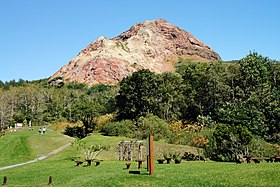Shōwa-shinzan
| Shōwa-shinzan | |
|---|---|
| 昭和新山 | |

Shōwa-shinzan (September 2008)
|
|
| Highest point | |
| Elevation | 398 m (1,306 ft) |
| Prominence | 211 m (692 ft) |
| Parent peak | Mount Usu |
| Listing |
List of mountains and hills of Japan by height List of volcanoes in Japan |
| Coordinates | 42°32′33″N 140°51′52″E / 42.54250°N 140.86444°E |
| Naming | |
| Translation | New Mountain of the Showa Era (Japanese) |
| Geography | |
| Location | Hokkaidō, Japan |
| Parent range | Nasu Volcanic Zone |
| Topo map | Geographical Survey Institute 25000:1 壮瞥, 25000:1 虻田, 50000:1 虻田 |
| Geology | |
| Mountain type | Lava dome |
| Volcanic arc/belt | Northeast Japan Arc |
| Last eruption | 1945 |
Shōwa-shinzan (昭和新山 Shōwa-shinzan?) is a volcanic lava dome in the Shikotsu-Toya National Park, Hokkaidō, Japan, next to Mount Usu. The mountain was created between 28 December 1943 and September 1945. Initially, a series of strong earthquakes shook the area, and wheat fields were rapidly uplifted. Lava broke through the surface and the current peak was created. The peak is now 398 m (1,306 ft) tall, and still actively smoking.
The name Shōwa-shinzan literally means "Showa new mountain", as it formed during the reign of Emperor Hirohito, known as the Showa period. When Shōwa-shinzan first appeared, the Japanese authorities were worried that it might be interpreted as an unlucky wartime omen, and its existence was kept secret. Much of the information about peak's formation during these years comes from local postmaster Masao Mimatsu, who kept detailed measurements of its progress.
Generally, the volcanic activity of Shōwa-shinzan can be divided into three main phases as recorded by Masao Mimatsu.
On 28 December 1943, earthquakes starting to occur frequently around Mount Usu, with occurrences of more than 200 times per day on some days. The hypocenter in the early days was located in the vicinity of Lake Tōya. As the year entered 1944, the hypocenter started to move toward the eastern part of the base of Mount Usu and this resulted in the protuberance of the overlying ground. Eventually the protuberance started to spread to the north, reaching up to heights of 50 meters in some areas. The Sōbetsu riverbed also started to rise, and many fissures started to appear in the surrounding farmlands. The longest fissure recorded was about 600 meters long. On 22 June 1944, there were about 250 earthquakes in one day, and accordingly the protuberance of the ground rose by 150 centimeters in one day.
...
Wikipedia
